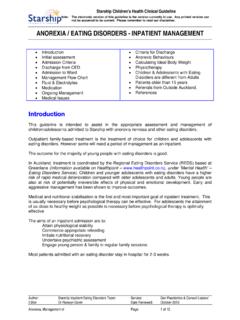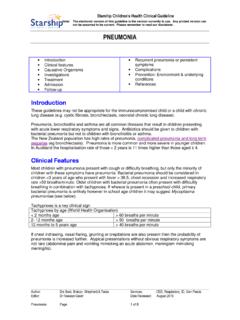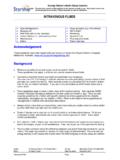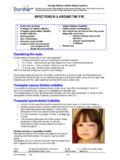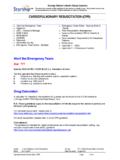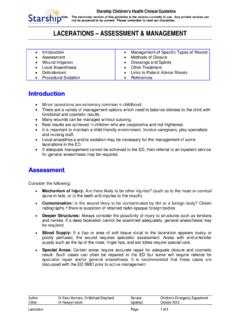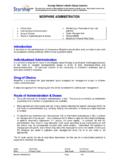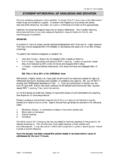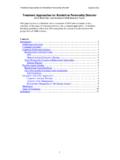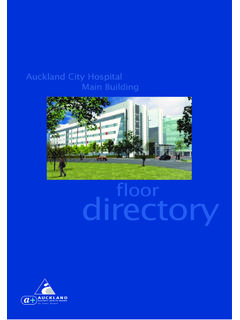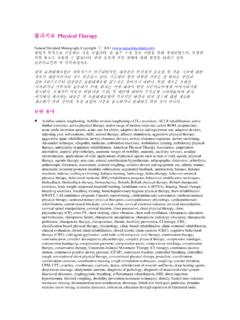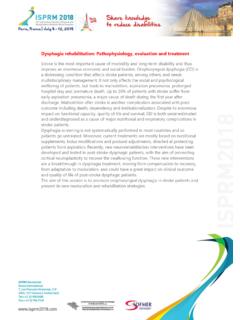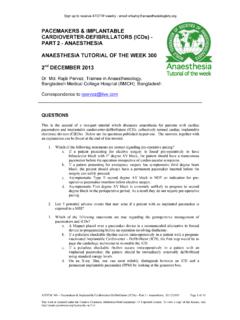Transcription of POISONING - PAEDIATRIC - Auckland City Hospital
1 Starship Children s Health Clinical Guideline Note: The electronic version of this guideline is the version currently in use. Any printed version can not be assumed to be current. Please remember to read our disclaimer. POISONING - PAEDIATRIC Author: Dr Emma Batistich, Dr Mike Shepherd Service: Children s Emergency Department Editor: Dr Raewyn Gavin Date Reviewed: September 2013 POISONING - PAEDIATRIC Page: 1 of 9 Introduction Approach to PAEDIATRIC Toxicology Resuscitation Risk Assessment Supportive Care Decontamination Enhanced Elimination Antidotes Disposition Prevention Resources Appendix - Toxidromes Introduction Unintentional POISONING is most common in the 12 to 36 month age group.
2 Most small children will only take 2 to 3 tablets or one mouthful of substance. Serious sequelae are rare. Supportive care and observation are the mainstays of treatment. Beware of causing harm - a risk assessment is essential before considering decontamination or treatment. Small ingestions of some substances can cause very serious injury in a small child. One or two tablets that can be lethal to a 10kg toddler Calcium channel blockers (eg Diltiazem, Verapamil), especially high dose slow release (SR) preparations Amphtetamines Dextropropoxyphene (in Paradex ) Tricyclic antidepressants Chloroquine Opioids Sulphonylureas Theophylline Small volumes of non-pharmaceuticals than can result in severe toxicity Organophosphates Paraquat Camphor Naphthalene Hydrocarbons, Solvents, Eucalyptus oil, Kerosene POISONING should be considered in the child with unexplained abnormal vital signs, altered neurology or metabolic disturbance.
3 Consider non accidental injury (NAI) in non-ambulatory children, older children or large ingestions. Older children/adolescents may present with deliberate self harm (intentional POISONING ). Starship Children s Health Clinical Guideline Note: The electronic version of this guideline is the version currently in use. Any printed version can not be assumed to be current. Please remember to read our disclaimer. POISONING - PAEDIATRIC Author: Dr Emma Batistich, Dr Mike Shepherd Service: Children s Emergency Department Editor: Dr Raewyn Gavin Date Reviewed: September 2013 POISONING - PAEDIATRIC Page: 2 of 9 Approach to PAEDIATRIC Toxicology 1. Resuscitation 2. Risk assessment 3. Supportive care 4. Decontamination 5.
4 Enhanced elimination 6. Antidotes 7. Disposition Resuscitation Resuscitation takes priority over decontamination and administration of antidotes (unless necessary for resuscitation NaHCO3) Airway Intubation likely to be indicated in the following situations: o Cardio-respiratory arrest o Airway injury o Corrosive ingestion o Decreased level of consciousness (GCS<8) or anticipated decrease in GCS o Prolonged seizures o Severe agitation or to facilitate treatment/investigations Breathing Oxygen/ventilation if required Circulation Support perfusion as needed o IV fluids (20ml/kg NaCl if shocked) (see Shock guideline) o Inotropes Treatment of hypertension (see Hypertension guideline) o Beta-blockers should be avoided in sympathomimetic toxicity Arrhythmia o NaHCO3 (1mmol/kg repeated as necessary)
5 If sodium channel blocker ingested Suspect if prolonged QRS, large R wave in aVR o Generally poor response to defibrillation in POISONING Examples of sodium channel blockers Tricyclic antidepressants Propranolol Class 1A and 1C antiarrhthmics - Quinidine - Flecanide First generation antihistamines Local anaesthetics - Cocaine - Bupivicaine Propranolol Dextropropoxyphene Carbamazepine Starship Children s Health Clinical Guideline Note: The electronic version of this guideline is the version currently in use. Any printed version can not be assumed to be current. Please remember to read our disclaimer. POISONING - PAEDIATRIC Author: Dr Emma Batistich, Dr Mike Shepherd Service: Children s Emergency Department Editor: Dr Raewyn Gavin Date Reviewed: September 2013 POISONING - PAEDIATRIC Page.
6 3 of 9 Disability Sedation (benzodiazepines are the mainstay) o Midazolam ( ) is most commonly used Seizure control (note NOT conventional treatment) o Repeat doses of Midazolam ( IV) o Phenobarbitone (20mg/kg IV) as second line o Phenytoin should NOT be used Prolongs sodium channel blockade Treatment of hypoglycaemia Maintain normothermia o Management of hyperthermia Benzodiazepines Physical cooling May require intubation and paralysis Risk Assessment Risk assessment is a distinct cognitive process through which the clinician attempts to predict the likely clinical course and potential complications for the individual patient at that particular presentation. Risk assessment should be quantitative and take into account agent, dose, time of ingestion, current clinical status and individual patient factors (for example, weight and co-morbidities).
7 The risk assessment is essential to determine the course of the POISONING and will guide treatment, investigations, period of observation and disposition. Attempt to elucidate and clearly document: 1) What substance(s) have been ingested? 2) How much of each substance has been ingested including a calculation of amount of substance per kg? 3) What time the ingestion occurred? 4) What clinical features have occurred thus far? 5) What other relevant patient factors (patient weight, other medical problems etc) are present? Then discuss with senior staff and/or consult poisons information If the ingestant is unknown: Consider all possible medications or toxins accessible in the house o All family members medications o Non-pharmaceutical agents o Drugs of abuse Conduct tablet counts of missing medication Consider the worst case scenario, including: That all the missing tablets were taken That the ingestion time is the latest time possible That there has not been significant spillage That one child has ingested all of the missing poison.
8 Starship Children s Health Clinical Guideline Note: The electronic version of this guideline is the version currently in use. Any printed version can not be assumed to be current. Please remember to read our disclaimer. POISONING - PAEDIATRIC Author: Dr Emma Batistich, Dr Mike Shepherd Service: Children s Emergency Department Editor: Dr Raewyn Gavin Date Reviewed: September 2013 POISONING - PAEDIATRIC Page: 4 of 9 Focused clinical examination Especially important if ingestant is unknown Toxidromes - See Appendix Screening tests No tests are routine These will be determined by risk assessment and may include: Blood sugar level ECG Paracetamol level o Should be requested in all children/young people following any intentional ingestion Other screening tests should be guided by risk assessment o Other drug levels o Blood gases o Radiology Supportive care For most children the only treatment required is good supportive care Observation Hydration Nutrition Sedation Treatment of o Hypo/hyperthermia o Hypo/hyperglycaemia o Agitation o Seizures Decontamination This is rarely required and must not distract from resuscitation and supportive care Skin o Wash off with soapy water Eyes o Irrigate with NaCl until pH
9 Is < GI tract o Dilution with milk/water is generally not recommended o Emesis should never be induced o Gastric lavage is not recommended as no demonstrated benefit compared to a single dose of activated charcoal. Starship Children s Health Clinical Guideline Note: The electronic version of this guideline is the version currently in use. Any printed version can not be assumed to be current. Please remember to read our disclaimer. POISONING - PAEDIATRIC Author: Dr Emma Batistich, Dr Mike Shepherd Service: Children s Emergency Department Editor: Dr Raewyn Gavin Date Reviewed: September 2013 POISONING - PAEDIATRIC Page: 5 of 9 o Activated charcoal (AC) Is rarely indicated in PAEDIATRIC POISONING The use of AC carries a risk of aspiration and subsequent chemical pneumonitis Indicated only if ALL of the following are true.
10 O Presentation within 1 hour of Ingestion o Toxin is adsorbed by AC o Patient is currently maintaining own airway and risk assessment determines that their GCS will remain normal o Otherwise only give if airway is protected o The substance has significant toxicity and is not easily treatable Dose = 1g/kg Can be made more palatable by mixing with ice-cream Toxins not adsorbed by activated charcoal Acids/alkalis Alcohols Metals and ionic compounds (iron, potassium, lithium) Hydrocarbons o Whole bowel irrigation (WBI) Is very rarely performed Indicated if: o Ingestion of a slow release or extended release substance or a substance not bound to AC and o Presentation prior to symptom onset and o Ingestion is likely to result in significant toxicity despite supportive care or antidote therapy Polyethylene glycol (Golytely) 30ml/kg/h until effluent runs clear) Possible indications for WBI Iron (>60mg/kg elemental iron ingested)
